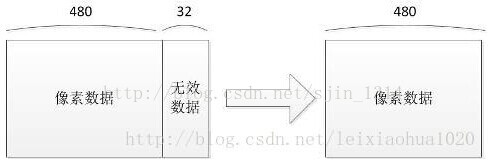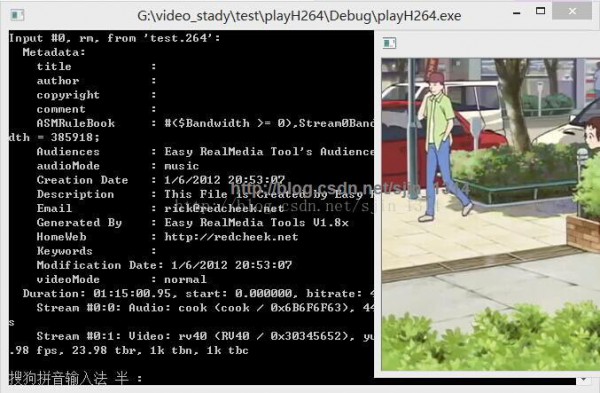/*File : playvideo.cpp
*Auth : sjin
*Date : 20141029
*Mail : 413977243@qq.com
*/
#include <stdio.h>
#include <cv.h>
#include <cxcore.h>
#include <highgui.h>
#ifdef __cplusplus
extern "C" {
#endif
#include <libavformat/avformat.h>
#include <libavcodec/avcodec.h>
#include <libswscale/swscale.h>
#pragma comment (lib, "Ws2_32.lib")
#pragma comment (lib, "avcodec.lib")
#pragma comment (lib, "avdevice.lib")
#pragma comment (lib, "avfilter.lib")
#pragma comment (lib, "avformat.lib")
#pragma comment (lib, "avutil.lib")
#pragma comment (lib, "swresample.lib")
#pragma comment (lib, "swscale.lib")
#ifdef __cplusplus
}
#endif
static void CopyDate(AVFrame *pFrame,int width,int height,int time)
{
if(time <=0 ) time = 1;
int nChannels;
int stepWidth;
uchar * pData;
cv::Mat frameImage(cv::Size(width, height), CV_8UC3, cv::Scalar(0));
stepWidth = frameImage.step;
nChannels = frameImage.channels();
pData = frameImage.data;
for(int i = 0; i < height; i++){
for(int j = 0; j < width; j++){
pData[i * stepWidth + j * nChannels + 0] = pFrame->data[0][i * pFrame->linesize[0] + j * nChannels + 2];
pData[i * stepWidth + j * nChannels + 1] = pFrame->data[0][i * pFrame->linesize[0] + j * nChannels + 1];
pData[i * stepWidth + j * nChannels + 2] = pFrame->data[0][i * pFrame->linesize[0] + j * nChannels + 0];
}
}
cv::namedWindow("Video", CV_WINDOW_AUTOSIZE);
cv::imshow("Video", frameImage);
cv::waitKey(time);
}
static void SaveFrame(AVFrame *pFrame, int width, int height, int iFrame)
{
FILE *pFile;
char szFilename[32];
int y;
// Open file
sprintf(szFilename, "frame%d.ppm", iFrame);
pFile=fopen(szFilename, "wb");
if(pFile==NULL)
return;
// Write header
fprintf(pFile, "P6
%d %d
255
", width, height);
// Write pixel data
for(y=0; y<height; y++)
fwrite(pFrame->data[0]+y*pFrame->linesize[0], 1, width*3, pFile);
// Close file
fclose(pFile);
}
int main(int argc, char * argv[])
{
AVFormatContext *pFormatCtx = NULL;
int i, videoStream;
AVCodecContext *pCodecCtx;
AVCodec *pCodec;
AVFrame *pFrame;
AVFrame *pFrameRGB;
AVPacket packet;
int frameFinished;
int numBytes;
uint8_t *buffer;
/*注册了所有的文件格式和编解码器的库*/
av_register_all();
// 打开视频文件
/*这个函数读取文件的头部并且把信息保存到我们给的AVFormatContext结构体中。
*第2个参数 要打开的文件路径
*/
if(avformat_open_input(&pFormatCtx, "test.264", NULL, NULL)!=0){
return ⑴; // Couldn't open file
}
// 读取数据包获得流媒体文件的信息
if(avformat_find_stream_info(pFormatCtx,NULL)<0){
return ⑴; // Couldn't find stream information
}
//打印输入或输出格式的详细信息,如时间、比特率,溪流,容器,程序,元数据,基础数据,编解码器和时间。
av_dump_format(pFormatCtx, 0, "test.264", false);
//查找第1个视频流
videoStream=⑴;
for(i = 0; i < pFormatCtx->nb_streams; i++){
if(pFormatCtx->streams[i]->codec->codec_type == AVMEDIA_TYPE_VIDEO){
videoStream = i;
break;
}
}
if(videoStream == ⑴){//未发现视频流退出
return ⑴;
}
//取得视频编解码器的上下文
pCodecCtx = pFormatCtx->streams[videoStream]->codec;
// 找到视频解码器
pCodec = avcodec_find_decoder(pCodecCtx->codec_id);
if(pCodec == NULL){//未发现视频编码器
return ⑴;
}
// 打开视频解码器
if(avcodec_open2(pCodecCtx, pCodec, 0) < 0){
return ⑴; //打开失溃退出
}
/*有些人可能会从旧的指点中记得有两个关于这些代码其它部份:
*添加CODEC_FLAG_TRUNCATED到 pCodecCtx->flags和添加1个hack来粗糙的修正帧率。
*这两个修正已不在存在于ffplay.c中。因此,我必须假定它们不再必 要。我们移除
*了那些代码后还有1个需要指出的不同点:pCodecCtx->time_base现在已保存了帧率
*的信息。time_base是1 个结构体,它里面有1个份子和分母 (AVRational)。我们使
*用分数的方式来表示帧率是由于很多编解码器使用非整数的帧率(例如NTSC使用29.97fps)。
*
*if(pCodecCtx->time_base.num > 1000 && pCodecCtx->time_base.den == 1){
* pCodecCtx->time_base.den = 1000;
*}
*/
// 分配保存视频帧的空间
pFrame = avcodec_alloc_frame();
// 分配1个AVFrame结构
/*准备输出保存24位RGB色的PPM文件,我们必须把帧的格式从原来的转换为RGB。FFMPEG将为我们做这些转换*/
pFrameRGB = avcodec_alloc_frame();
if(pFrameRGB==NULL){
return ⑴;
}
/*即便我们申请了1帧的内存,当转换的时候,我们依然需要1个地方来放置原始的数据。
*我们使用avpicture_get_size来取得我们需要的大小,然后手工申请内存空间:
*/
numBytes = avpicture_get_size(PIX_FMT_RGB24, pCodecCtx->width, pCodecCtx->height);
buffer = (uint8_t *)av_malloc( numBytes*sizeof(uint8_t));
// 基于指定的图象参数,设置图片字段所提供的图象数据缓冲区。
avpicture_fill((AVPicture *)pFrameRGB, buffer, PIX_FMT_RGB24,pCodecCtx->width, pCodecCtx->height);
/*读取数据帧
*通过读取包来读取全部视频流,然后把它解码成帧,最好后转换格式并且保存。
*/
i=0;
long prepts = 0;
while(av_read_frame(pFormatCtx, &packet) >= 0){
if(packet.stream_index == videoStream){/*判断读取的是不是为需要的视频帧数据*/
// 解码视频帧
avcodec_decode_video2(pCodecCtx, pFrame, &frameFinished, &packet);
if(frameFinished){
static struct SwsContext *img_convert_ctx;
#if 0
//就的转换模式已废除
img_convert((AVPicture *)pFrameRGB, PIX_FMT_RGB24, (AVPicture*)pFrame, pCodecCtx->pix_fmt, pCodecCtx->width, pCodecCtx->height);
#endif
if(img_convert_ctx == NULL) {
int w = pCodecCtx->width;
int h = pCodecCtx->height;
//分配和返回1个SwsContext。您需要履行缩放/转换操作使用sws_scale()。
img_convert_ctx = sws_getContext(w, h, pCodecCtx->pix_fmt, w, h, PIX_FMT_RGB24, SWS_BICUBIC,NULL, NULL, NULL);
if(img_convert_ctx == NULL) {
fprintf(stderr, "Cannot initialize the conversion context!
");
exit(1);
}
}
////转换图象格式,将解压出来的YUV420P的图象转换为BRG24的图象
sws_scale(img_convert_ctx, pFrame->data, pFrame->linesize, 0, pCodecCtx->height, pFrameRGB->data, pFrameRGB->linesize);
//保存前5帧数据
if(i++ <= 5){
SaveFrame(pFrameRGB, pCodecCtx->width, pCodecCtx->height, i);
}
CopyDate(pFrameRGB, pCodecCtx->width, pCodecCtx->height,packet.pts-prepts);
prepts = packet.pts;
}
}
//释放空间
av_free_packet(&packet);
}
//释放空间
av_free(buffer);
av_free(pFrameRGB);
// 释放 YUV frame
av_free(pFrame);
//关闭解码器
avcodec_close(pCodecCtx);
//关闭视频文件
avformat_close_input(&pFormatCtx);
system("Pause");
return 0;
}
运行以下图:


